You can blame it on the evil cell phone corporations, but lack of cell coverage is as much the fault of nimbyism as it is any nefarious capitalist plot. Yeah, most of us love (or at least need) our mobiles — but don’t put a tower within a mile of MY house, and oh, that one you want to put over there is ugly so don’t do it. Result, even major highways here in Colorado have numerous dead spots.
But you can compensate. Since calling from inside a vehicle attenuates your phone signal, first step is to rig an external antenna system. After that, hook up an amp such as Wilson Signal Boost and get even more range. So we did.
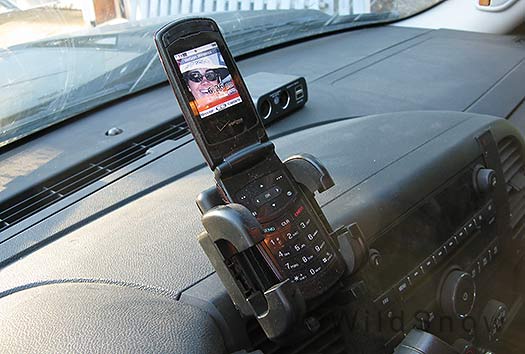
Looks like a simple cell phone holder, but no, this Wilson cradle picks up signal to and from phone, boosts it, and gives you two or three more bars.
I’ve experimented quite a bit with this stuff over the years. You can get a modest but noticeable improvement (one bar or so) by just hooking up to a mag-mount antenna on the roof of your car. Thing is, it’s a bit of trouble to do this and the improvement is indeed minimal. But, include an amp in the system and you’ll be blown away by your bar count.
You can find cell phone amplification systems from a variety of sources, but we’ve always felt that Wilson Electronics had the best engineering and quality. Thus, to begin our project we began with the Wilson kit containing an antenna, amp, and phone cradle. Basically, the cradle is just an antenna that helps the phone talk with the amp. Downside of this is your phone needs to be on or within a few inches of the cradle for the system to work, so you’ll need some kind of hands free talk setup.
That said, you can avoid the need for a hands-free setup by choosing Wilson sensor/antennas that attach to the back of your phone, or mount in the vehicle near where you’re using the phone, but I like the idea of a more positive yet simple connection so I chose the cradle option. (Some phones come with external antenna connectors that yield a super positive connection, but are prone to damage and yet another thing to fiddle with. For amplification, ‘passive coupling’ with a cradle seems to work just as well and keeps it simple.)
Of course we’re never satisfied with standard tech. So knowing we’d be in super marginal reception zones, we also got a Wilson “Trucker” antenna that is said to be their strongest for cell phone transmit/receive. The Trucker antenna has the correct cable connectors to integrate with the Signalboost kit (though for integration with our slide-in camper we’ve been installing some extra connectors in the system, more about that in another blog post).
Before we go on to some photos and details of the install in our backcountry skiing transport vehicle, how about our test results? In a word, amazing. My combined Trucker antenna and amp system results in two to three more bars in places where before I’d only had one to none. Even more important, on a rural drive I’ve been doing almost daily, my system range has been extended from drop point that was only a few miles out of town, to 16 miles up a canyon (with one three minute dead zone)!! That section of driving takes me about 40 minutes both ways, so by installing the Wilson system I’ve got about 40 extra minutes a day to do my phone business. (Don’t get the idea I’ve got my phone super-glued to my ear, but I do spend a bit of time on it every day, and getting to do some of that while driving is a huge time saver.)
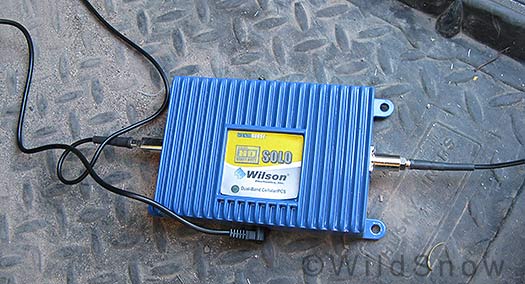
The amplifier is about the size of a large person's hand. It requires three wires, one from the phone cradle, one for power, and one out to the antenna. The kit comes with good directions on how to route the wires. The amp is durable and heat resistant, so it can be stored or mounted just about anywhere in the cabin, just make sure the wire and cable connectors are protected from damage.
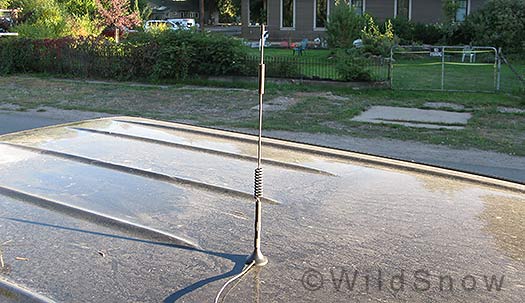
This elegant mag-mount antenna (12 inches tall) comes with the Wilson kit. It works fine for your average problems with dead spots on the highway, but if you're seeking maximum range consider using something taller (and uglier).
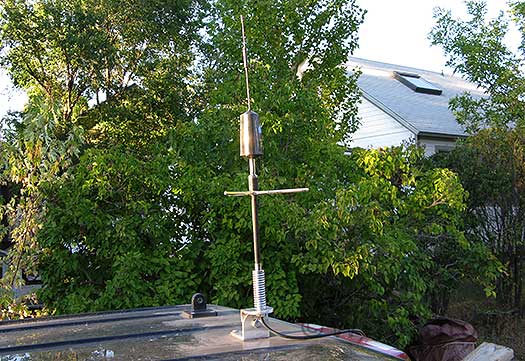
This Wilson 'trucker' antenna shouts 'geek on board,' but it gives me about one bar more over the small mag-mount. It didn't seem to extend maximum range in my test canyon, but fringe zone calls had better quality. Thus, most people would be perfectly happy with the mag-mount that comes with the kit. As you can see in photo, I mounted this big stick on a pivot bracket so I can tilt it back for low hanging branches, or remove it entirely when we use our slide-in camper.
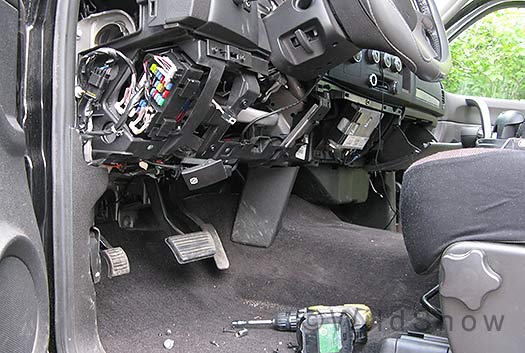
Installing the amp requires a feed wire from the dash cradle. You can run this fairly cleanly by just bringing it down the front of your dashboard and perhaps attaching with some small velcro tabs. I prefer 'factory' style installs, so I popped out my dashboard and routed the feed wire so it's not visible. Now that testing is done, I'll hide the amp and other wires as well.
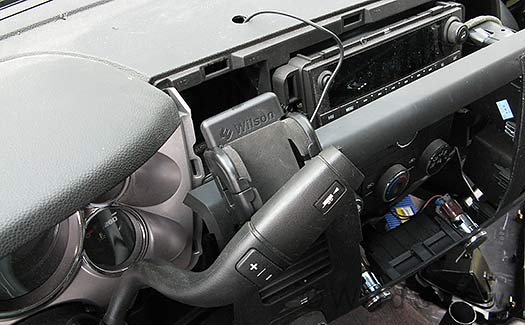
To get the cradle wire behind the dash, I routed it through a clean hole hidden behind the cradle. Yeah, we like drilling holes in new trucks, it adds character!
A note about Wilson boosters: Their minimalist setups such as the MobilePro will give you a slight improvement and may be all you need it you’ve always got a signal and are just seeking to improve it. But if you want to eliminate dead zones and increase your range, go for a full-on amplification system — it will be money well spent.
For testing, I left the amp uninstalled and didn’t do a clean job of routing my antenna wires. Once everything is tidied up and I’ve used the rig for a while, I’ll file a final report. Till then, some of you who need your cell phone time might want to consider a Wilson system for your backcountry skiing trailhead approach vehicle.
WildSnow.com publisher emeritus and founder Lou (Louis Dawson) has a 50+ years career in climbing, backcountry skiing and ski mountaineering. He was the first person in history to ski down all 54 Colorado 14,000-foot peaks, has authored numerous books about about backcountry skiing, and has skied from the summit of Denali in Alaska, North America’s highest mountain.
